Inside the effort to kill protections for endangered animals
The Endangered Species Act is credited with saving grizzly bears and more than 200 other animals from extinction. Efforts to chip away at the law persist.
The Crow tribespeople call the grizzly bear their ancestor, the Elder Brother who protects their home, which is the land.
They have grizzly bear songs, grizzly dances, grizzly names for their children, grizzly lullabies that women sing to infants, and grizzly spirits that guide warrior societies and guard tepees, transform into human beings, and beguile their daughters.
So when the United States Fish and Wildlife Service said that grizzly populations in the Greater Yellowstone Ecosystem—encompassing portions of Wyoming, Montana, and Idaho—would be removed from the U.S. government’s endangered species list this year and opened for hunting, I traveled to Montana to meet the chairman of the Crow Nation, A. J. Not Afraid, who has lobbied to stop the delisting.
We stood on a promontory in the Big Horn Mountains called Pretty Eagle Point, where Not Afraid showed me the grizzly habitat on the 2.3-million-acre reservation. In the distance there were snowbound peaks where grizzlies in summer eat army cutworm moths, and broad plateaus where the bears graze the grass and dig for grubs.
There were forests of fir and pine, watersheds feeding the streams that over millions of years carved the dark chasms of Big Horn Canyon and Black Canyon, where the bears like to amble in the rushing flow looking for fish.
Not Afraid, 43, had testified before Congress a few weeks before my April visit. He said he believed that delisting the grizzly would be a calamity for the animal.
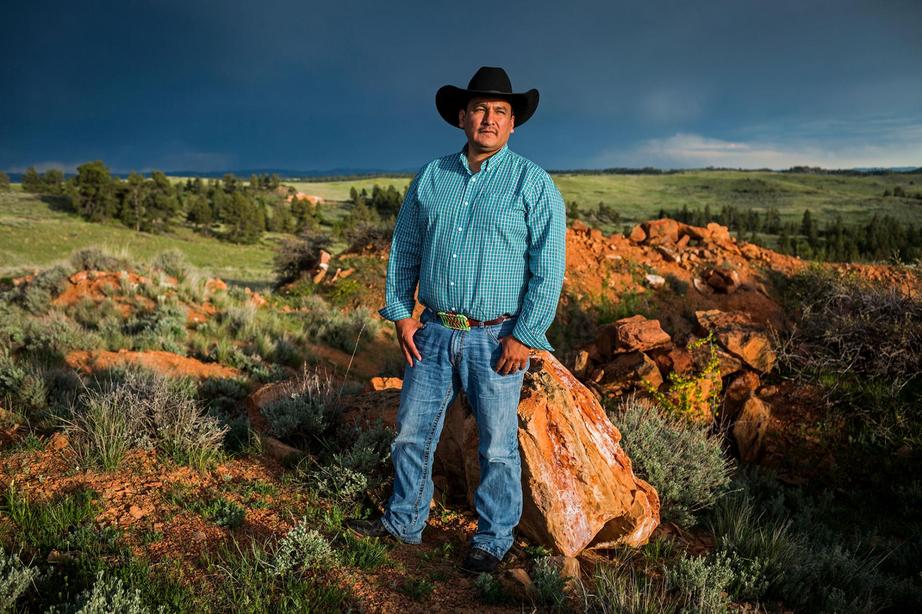
A. J. Not Afraid, chairman of the Crow Nation in Montana, is fighting to keep grizzlies—which are sacred to Native Americans—protected under the Endangered Species Act.
Photograph by Katie Orlinsky, National Geographic
He said that grizzly populations in the region did not appear to have recovered since being protected 42 years ago, as the Fish and Wildlife Service claimed, that Crows hardly ever see them anymore on the reservation, and that the trophy hunting unleashed with delisting would be an affront to tribes that hold the creature sacred.
“Fall of 2013 was the last time I saw a grizzly,” he said. He was hunting elk. There was a buffalo carcass on a slope where the bear had been feeding. The bear passed before him at a lope, 50 yards away. He recalled the vision sadly. “Because of the decrease in grizzlies, we encounter them only every few years now.”
I told him that I had listened recently to the last recorded words of one of the tribe’s greatest chiefs, Joe Medicine Crow, who spoke of the grizzly’s future. “It’s not grizzly bears that are problematic; it’s man,” said Medicine Crow, who died in 2016 at the age of 102. “We have to control man himself and keep grizzly bears alive. The government needs to keep protecting them.”
“Joe Medicine Crow hit it right on the head,” Not Afraid said.
A HISTORIC LAW
The grizzly bear, federally protected since 1975, is alive in the lower 48 states only because of the Endangered Species Act (ESA), one of the most powerful environmental statutes in the U.S. and one of the world’s strongest species protection laws.
It was the first law of its kind to argue, in the words of the man who wrote it, Representative John Dingell, a Michigan Democrat, “that only natural extinction is part of natural order.”
The Fish and Wildlife Service, which manages the endangered species list, says that grizzlies in the Greater Yellowstone Ecosystem have rebounded from 136 in 1975 to roughly 700 today. Before Europeans settled America, an estimated 100,000 or more of the bears ranged across the West, from present-day California to Kansas, from the Dakotas to northern Mexico.
Critics say the ESA is ineffective because so many species remain on the list, but supporters say that is exactly what illustrates its enormous success
Species listed and delisted from the Endangered Species Act
In 2017,
1,653 species are listed as endangered or threatened and protected by the ESA
37 are recovered
10 are extinct
NOTE: Nineteen species were listed in error and are not shown. SOURCE: U.S. FISH AND WILDLIFE SERVICE
But today, with both the House and the Senate in the hands of a Republican leadership that has declared war against environmental regulations, and with a president who has expressed similar views, the ESA itself may be as threatened as the grizzly.
From the moment Congress approved it, in 1973, the law has been attacked by those who believe it overly burdens the American economy and the ability of businesses and industries to prosper.
Idaho Republican Representative Raul Labrador, a member of the ultraconservative Freedom Caucus, said in a recent speech that the ESA “severely hinders our nation’s ability to provide necessary public services and discourages investment in critical projects needed to boost our economy.”
Since 1973 six federal circuit courts have considered and rejected challenges to the ESA's constitutionality, leaving the law intact. In Congress there have been scores of attempts to weaken it by little cuts.
ESA advocates, including conservation groups and most elected Democrats, warn that Republicans are now gearing up for an unprecedented assault. “The Republicans are pushing bills to divert protection funding, prioritize corporate land development, and sidestep science,” says Representative Raul Grijalva, a Democrat from Arizona. “These are blatant efforts to place corporate interests over species survival.”
During the past five months Republicans have introduced 25 proposals to skirt, hamper, defang, or undermine endangered species protections. These include bills to amend the ESA to abandon its requirement to use “best available science” in listing decisions and to hand oversight of some of the law’s key management and decision-making provisions to state governments historically hostile to the act.
Saved by the ESA
Other bills aim to free oil and gas development on federal public lands from ESA considerations, allow water diversion projects in California without ESA review, waive ESA rules in the logging of national forests in the Pacific Northwest, ignore ESA procedures in the delisting of now protected wolves in the Great Lakes states, and add layers of bureaucracy to the Fish and Wildlife Service.
For many species, wildlife biologists say, the ESA has been remarkably successful in doing what Dingell designed it to do. Because of the ESA we still have in the wild not only the grizzly bear but also the bald eagle, the California condor, the Columbian white-tailed deer, the Florida panther, the peregrine falcon, the North Atlantic right whale, the American alligator, the wood stork, the spotted owl, and the gray wolf, among many others.
Scientists have concluded that 227 species would have gone extinct between 1973 and 2005 without the ESA’s protections. Its broad mandate that vast stretches of habitat require protection in order to preserve the creatures living in them has produced cascading benefits for ecosystems in the Pacific Northwest, the Everglades, the Chesapeake Bay, Shenandoah National Park, and along the New England coast.
Since 1973 more than 1,600 animal and plant species have been declared endangered or threatened, and the great majority are headed toward recovery because of the ESA, researchers say.
Republicans say the ESA needs updating to meet the demands of 21st-century America. That push is led by the House Natural Resources Committee, chaired by Rob Bishop, a Utah Republican who exercises broad purview over wildlife legislation. Bishop declined to be interviewed for this article. But at a House hearing last December, he spoke candidly of his intentions. “I would be happy to invalidate the Endangered Species Act,” he said.
‘ANTISCIENCE IGNORAMUSES’
Recently I called up John Dingell to ask him about the outlook for the law he authored. “With this Congress we should be in terror,” he said.
Dingell served in Congress for 59 years before retiring in 2015, and at age 90 he is known as the lion of endangered species protection. Don Barry, a conservation lawyer who worked for the Fish and Wildlife Service as chief counsel during the 1970s, told me, “Without John Dingell, we wouldn’t have the ESA.”

This little fish, the snail darter, was at the center of a 1976 Supreme Court case finding that species listed as endangered should be afforded the highest protections.
Photograph by Joel Sartore, National Geographic Photo Ark
Dingell was a ranger for the National Park Service before he became a lawmaker. He worked at Rocky Mountain National Park and Rainier National Park. He trapped errant bears, fixed outhouses, conducted search and rescue in the backcountry. His first love was hunting, fishing, camping.
After he went to Congress—he was elected in 1955—Dingell built a log cabin on a hundred acres near the Shenandoah Valley, a few hours southwest from the Capitol. “The bears’d run right up and down the driveway. That was heaven.”
“I wrote much of the Endangered Species Act in my head while I was driving to and from work,” Dingell said. “If I wasn’t going to be in the wilderness, I was going to use my time out of it to write legislation to protect it.”
The ESA passed the House and Senate by margins that in the current partisan climate would be astonishing: 92 to zero in the Senate, 390 to 12 in the House. President Richard Nixon, a Republican, signed the law without hesitation.
I asked Dingell if he could get the ESA passed today.
“I don’t think I could pass the Lord’s Prayer in that nuthouse,” he told me, referring to Congress. “The ESA was written so that scientific principles would be used to protect species. Science would make the decisions, science would decide the case. Today we have a bunch of antiscience ignoramuses and vicious lying people in Congress. And we’re going to pay a hellacious price.”
Protected or Once-Protected Species
Last March the House Subcommittee on Oversight and Investigations, part of the House Natural Resources Committee, held a hearing on what were described as the ESA’s “impediments to economic and infrastructure development.” Representative Labrador chaired the hearing, and opened it by calling the ESA “dysfunctional.” (Labrador’s office did not respond to requests for comment.)
The subcommittee heard testimony from the general manager of the Idaho-based Hecla Mining Company, Douglas Stiles, who claimed that the ESA had held up one of Hecla’s mining projects for close to 30 years. Stiles said the act’s requirements were “complicated, expensive, and time-consuming” and an obstacle to “bringing much needed economic development to rural America.”
Labrador noted that the project in question, the Rock Creek silver and copper mine, in Sanders County, Montana, “would have generated many local jobs and benefits to rural Montana” but was “held up” by the Fish and Wildlife Service’s “shifting requirements.”
(video can be accessed at source link below)
Is It Okay to Let These Wolves Go Extinct?
Noah Greenwald, the endangered species director at the Center for Biological Diversity, a nonprofit advocate for species survival, told me that the Rock Creek project “has not been stalled by the Fish and Wildlife Service’s shifting requirements but rather by massive local opposition and questions by the Forest Service about potential impacts on water quality, endangered species, and wilderness.”
Last among the witnesses was Ya-Wei Li, an endangered species attorney at Defenders of Wildlife who has investigated allegations that the ESA is bad for local economies.
I called up Li a week after the hearing. “We hear all these claims about killing jobs, driving down the economy, because [the ESA] is supposedly being implemented like a blunt hammer,” Li told me. “But the evidence doesn’t show it.”
In a study in the Proceedings of the National Academy of Sciences, Li and colleague Jacob Malcolm examined the results of 88,290 ESA-mandated consultations from January 2008 through April 2015. They concluded that during the seven-year study period “no project was stopped or extensively altered” as a result of ESA-mandated consultations.
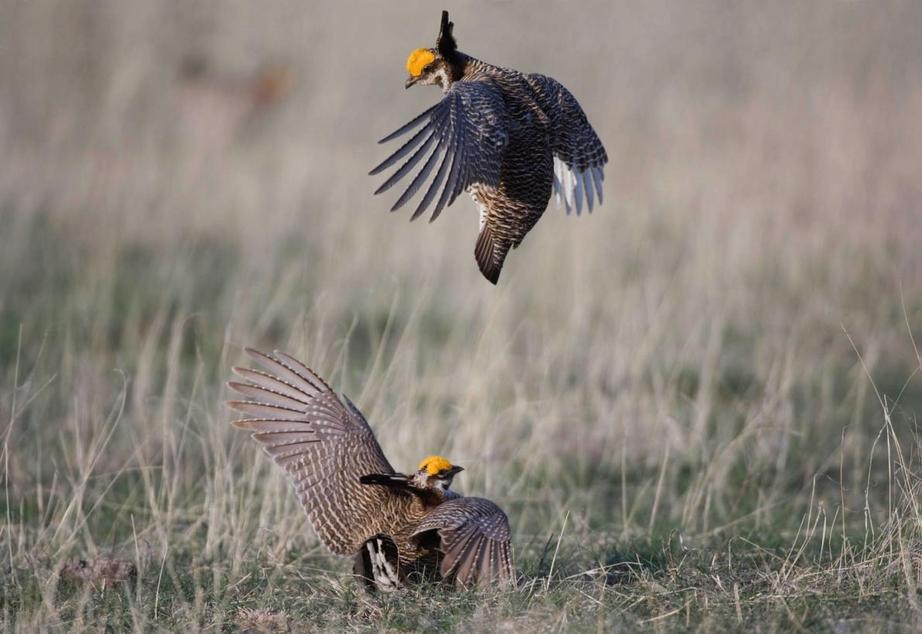
The petroleum industry successfully sued to have the lesser prairie-chicken taken off the endangered species list last year. Conservationists are fighting to reverse that decision.
Photograph by Rolf Nussbaumer
THE CASE OF THE LESSER PRAIRIE-CHICKEN
One of the proposals to change the ESA, introduced in April 2017 by Senator Dean Heller, a Nevada Republican, would require any decision to protect a species to “be made only with the consent of the Governor of each state in which the endangered or threatened species is present.”
This echoes a common refrain among those seeking to weaken the ESA: Endangered species protections would be more adroitly handled by state governments and state wildlife agencies.
“We can better protect endangered species by empowering state leaders to implement a strategy more tailored to their specific circumstances,” said co-sponsor Senator Rand Paul, a Kentucky Republican who co-sponsored the proposal. He said the change would put “local needs first” and guard against “bureaucratic overreach.”
One example of the Fish and Wildlife Service deferring to western states on species protection serves as a cautionary tale. The lesser prairie-chicken, a species of the grouse family, ranges across the shortgrass prairies and oak shrub steppe of eastern New Mexico, the Texas Panhandle, and parts of Oklahoma, Kansas, and Colorado.
Steps to delist or “downlist” a species
1. Species reaches goals specified by a recovery plan, such as self-sustaining populations or improved habitat quality.
2. Biologists determine whether the species still needs protection by assessing key threats to its livelihood, including predation, disease, and man-made factors.
3. Biologists solicit opinions from independent scientists, federal and state agencies, and the public, after a status change is formally proposed by the Fish and Wildlife Service.
4. Species is removed from the ESA list or downlisted from “endangered” to “threatened,” if no contradicting information is offered. Researchers continue to monitor the species.
ICONS: ÁLVARO VALIÑO.
Once numbering in the millions, prairie-chickens have plummeted to roughly 25,000 birds on less than 17 percent of their original range because of habitat fragmentation caused by oil and gas drilling, agricultural land conversion, and other activities. As a result, in 2014 the Fish and Wildlife Service listed the bird as threatened.
As part of that listing decision, the Service opted to “streamline the regulatory process” under a section of the ESA that allows the agency to “customize prohibitions” and provide “regulatory flexibility.”
In its streamlining process for the prairie chicken, the Service in 2013 made an agreement with the wildlife departments of the five western states where the bird is found. Those departments, represented by the Western Association of Fish and Wildlife Agencies, produced a “rangewide plan” that the Fish and Wildlife Service approved. The idea was to limit the economic effects of any species protections by allowing continued oil and gas drilling and other potentially damaging activities in bird habitat.
Don Barry, the former chief counsel for the Fish and Wildlife Service, closely followed the process. Barry helped the Service draft the core rules for implementing the ESA, and he authored many of the early legal opinions that still govern the agency. The Western Association of Fish and Wildlife Agencies, Barry said, “scrambled to put together a management program to keep the species from declining. The Service waived its own regulations and deferred to the state plans—which effectively have done little to protect the lesser prairie-chicken.”

Encounters with wind turbines are a threat to species like the endangered Indiana bat.
Photograph by Ken Cedeno, Corbis via Getty Images
When the Fish and Wildlife Service issued its 2016 progress report on the association’s rangewide plan, it found that the association had not completed “any qualifying restoration activities during this reporting period” and that not enough data had been collected to assess the plan’s overall progress.
In 2014 the Permian Basin Petroleum Association, which represents oil and gas companies in prairie-chicken habitats, filed suit in federal court against the Department of the Interior to try to stop federal protections for the bird. A U.S. district court backed the oil group, saying federal protections were unnecessary because of the efforts by the states and the Western Association of Fish and Wildlife Agencies.
“Lesser prairie-chickens are now in worse shape than they were even two years ago,” Bethany Cotton, wildlife program director of the conservation group WildEarth Guardians, told me.
SCANT RESOURCES, POLITICIZED SCIENCE
Those fighing the ESA in Congress like to point to what they claim is the major failing of the law: Fewer than 2 percent of the 1,653 listed species have been declared recovered and removed from ESA protection, according to Parish Braden, communications director for the House Natural Resources Committee.
“The ESA’s primary goal to recover and protect species has been largely unsuccessful,” Braden said in a statement to National Geographic. Braden added in an email: “Reforms are needed so that success isn't measured by the number of species listed, but instead by recovering and de-listing those that are currently listed.”
“Nobody who cares about endangered species would ever measure success by the number of species listed,” Noah Greenwald said.
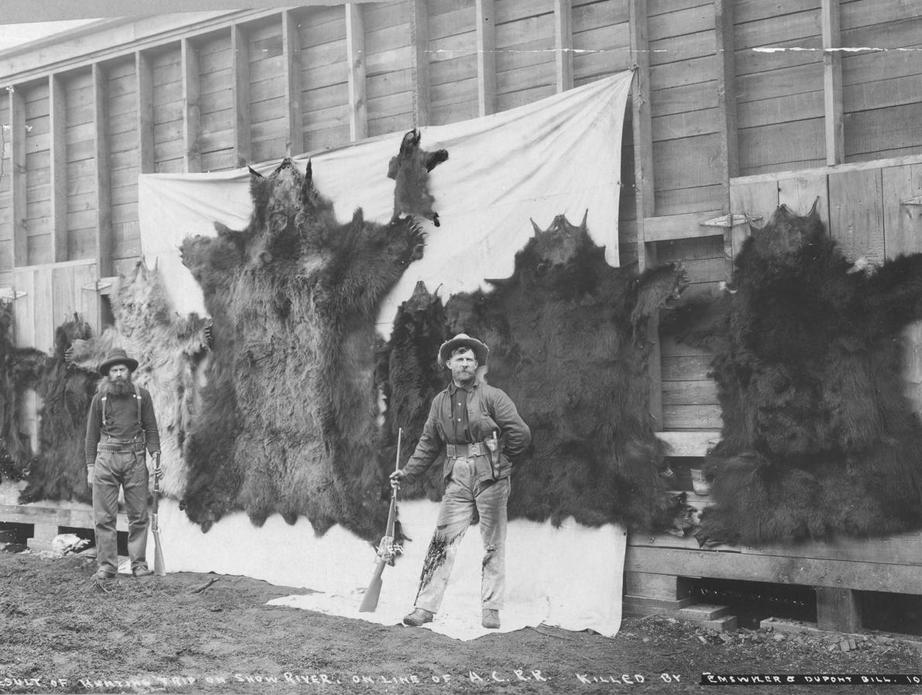
Hunters in Alaska display grizzly trophies in 1906. Scientists argue that removing ESA protections for grizzlies in the lower 48 today would be rash.
Photograph by Emswyler and Dupont Bill
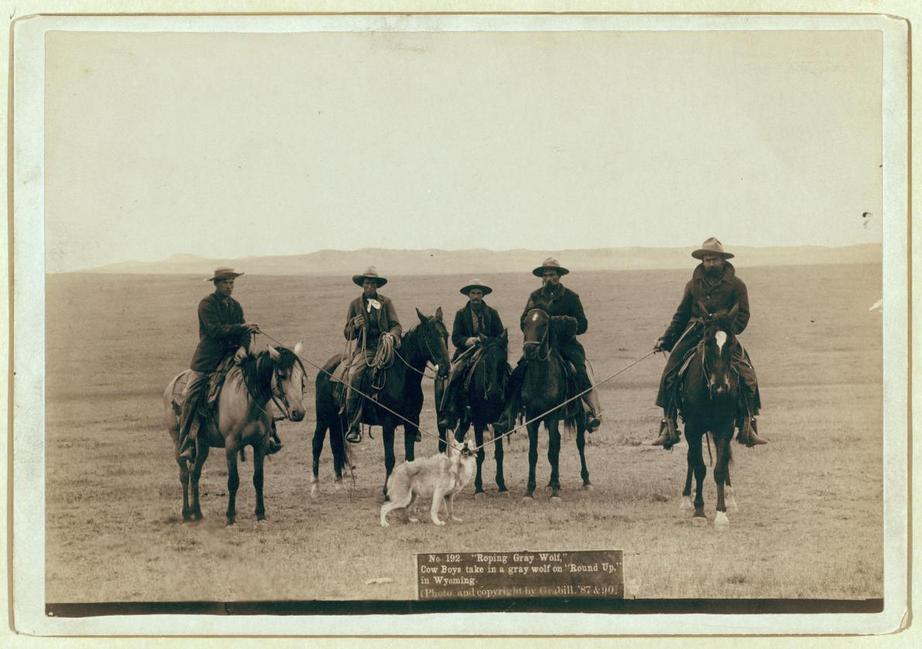
Cowboys in Wyoming pose with a gray wolf they lassoed on the range in 1887, nearly a hundred years before the animals received ESA protection.
Photograph by John C.H. Grabill, Library of Congress
Ninety-nine percent of the species on the list have been spared extinction, if not fully recovered. And it is true, says the U.S. Fish and Wildlife Service, that less than 2 percent of species have been declared recovered. “This is perhaps because it took decades for them to decline to the point of endangerment,” Greenwald told me. (Fish and Wildlife Service spokesman Brian Hires, writing in an email, concurred with this assessment.)
And it could take many more decades for them to come back to the point where scientists can agree that their populations are healthy, in habitat that gives them a chance to thrive. It takes time for a species to recover. Consider the bald eagle, one of the first species to be listed and declared recovered only in 2007 after 34 years of protection. Nearly half of all listed species have been protected for less than 20 years.
Greenwald and others say that if ESA critics really want to modernize the law for the 21st century, if their real concern is recovery and delisting, they could do something lawmakers in Washington haven’t done in decades: Increase funding for the Fish and Wildlife Service.
“My main aggravation,” said David Parsons, a senior biologist who worked for the Fish and Wildlife Service in a career spanning 24 years, “is the degree to which the agency embraces and caters to constituencies, interest groups, and politicians that are hostile to the mission of the agency. Agency biologists operate in an atmosphere of intimidation and fear of reprisal,” he said.

A grizzly bear on the move in Yellowstone National Park.
Photograph by Ronan Donovan, National Geographic
THE FATE OF THE GRIZZLY
When in April 2016 the Fish and Wildlife Service made public its proposal to remove ESA protection for the grizzly bear in the Greater Yellowstone Ecosystem, it received more than 850,000 comments from the public. Delisting would involve, among other measures, the opening of a hunting season. Grizzly bears would be killed not for meat, but for trophies. (Read National Geographic's coverage of Yellowstone National Park).
After decades of ESA protection, grizzly populations in Yellowstone eventually rebounded
Before protection, the range of the grizzly bear had receded almost entirely from the contiguous United States. Now, however, populations in Yellowstone have recovered, prompting researchers to propose delisting it.
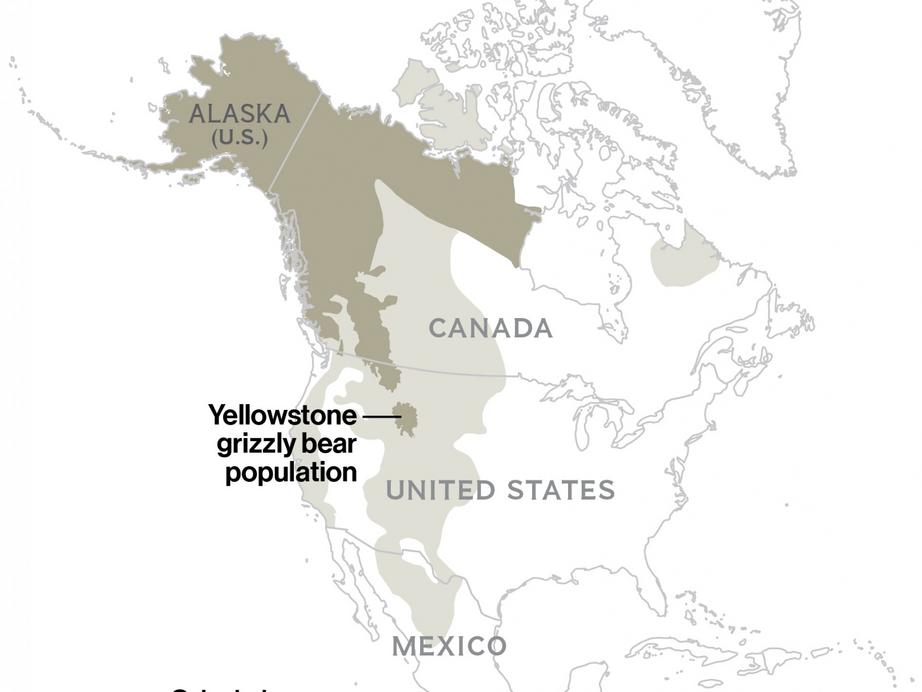
SOURCES: Interagency Grizzly Bear Study Team; M. Proctor, Birchdale Ecological; IUCN
Among the dissenting comments was a 73-page document submitted by a retired National Park Service biologist, David Mattson, who has studied grizzlies in the Greater Yellowstone Ecosystem since their listing under the ESA in 1975.
One of the problems in the 2016 delisting proposal, according to Mattson, is that it downplays the effects of climate change on food sources integral to the health of grizzlies. Those foods—cutthroat trout, whitebark pine nuts, and army cutworm moths, all found in high rugged remote elevations or in places unfrequented by people—are diminishing.
“The Fish and Wildlife Service claims this is not an issue,” he told me.
Equally troubling, Mattson said, is the Service’s claim that the number of grizzlies has been increasing steadily in recent years. Mattson has evidence showing the opposite. “We’ve had record-breaking mortality the last three years running, because bears are resorting to foods that are incredibly hazardous,” he said. They now look for elk in areas where game hunters travel—or for grasses and berries at lower elevations where there are more tourists, or they eat cattle—all of which places them in conflict with human beings who respond with mortal force.
Mattson thinks the Fish and Wildlife Service is “caving to the pressures from the proponents of delisting, which are the state wildlife management agencies, state elected officials, the Congress members, and the governors of Idaho, Montana, and Wyoming.”
Grizzly bear populations are growing, but their threats remain a subject of debate
Mattson worries especially about the impact that the unprecedented pace of climate change could have in bear habitat areas. A population limited to fewer than 700 bears in the Greater Yellowstone is not one that can easily ride out the accelerating changes, he said.
“If we’re looking realistically at ensuring the survival of the grizzlies,” Mattson told me, “those numbers are not enough to guard against the destructive trends afoot. We’re not being cautious.”
In March, Crow Chairman A. J. Not Afraid traveled to Washington, D.C., to lobby Congress about the need to keep the ESA protections of the grizzly in place. Not Afraid was joined by Chief Stan Grier, of the Piikani Nation, part of the Blackfoot Confederacy.
In a recent letter to the United Nations Special Rapporteur on the Rights of Indigenous Peoples, Grier wondered why the Fish and Wildlife Service had designated Amec Foster Wheeler, a multinational consultancy whose clients include major oil and gas corporations, to manage the scientific peer review of grizzly delisting. “When you learn that a former Halliburton executive, Jon Lewis, is now CEO of Amec, you start to understand why,” Grier wrote.

Trash is food to wildlife. A predator-proof container is tested at the Grizzly and Wolf Discovery Center in West Yellowstone, Montana.
Photograph by Michael Nichols, National Geographic
He added: “There are presently 21 oil and gas ‘Plans of Operation’ for Greater Yellowstone upon the delisting of the grizzly. Those will threaten cultural and environmental harms to Tribal Nations’ sacred and historic sites, and to treaty lands in the region.”
Not Afraid and Grier were among those who signed a 2016 treaty with more than 125 tribes. It demanded that the U.S. government—meaning the Fish and Wildlife Service—consult fully with the tribes before issuing a decision about the fate of the grizzly. The Service has not done so, according to the tribes, and they consider this a breach of their sovereignty.
One day standing on Pretty Eagle Point, on the Crow lands, I asked Not Afraid if the Crow people kept the stuffed heads of grizzlies on the walls of their homes. He seemed stunned by the question. One of his associates, a lively man named Truman Jefferson, Jr., cut in, “We don’t do it. We don’t hunt bear. We let it be. It lets us be. I read something that we just lost the white rhino. We’ll never see it again.”
We discussed the words of Joe Medicine Crow, who said that man is the most dangerous animal. “He’s the most dangerous animal,” Not Afraid said, “because he can take away forever something that belongs only to Mother Earth.”
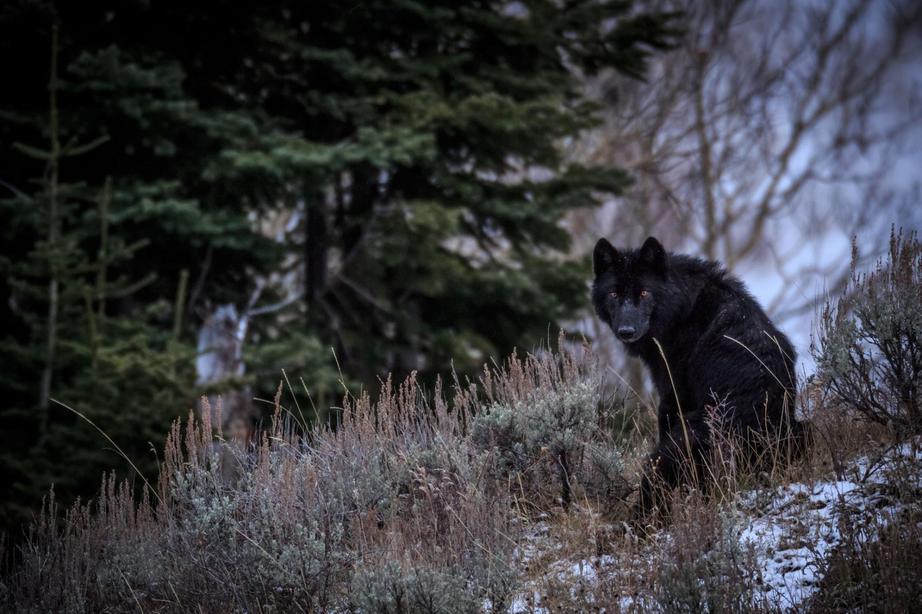
Gray wolves in Wyoming were taken off the endangered species list in March, shifting management of the animals from the federal government to the state.
Photograph by Ronan Donovan, National Geographic
Video can be accessed at source link below.
